|
Printables |
PowerPoints |
Online exercises |
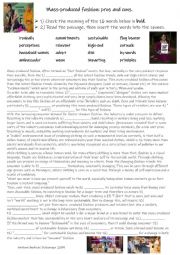
|
Mass-produced fashion pros and cons.
Reading passage with a gap fill exercise about being aware of the advantages and disadvantages of today�s fashion market. This sheet is suitable for higher level B1 to B2 students of all ages. An answer sheet is included. For higher level students they could be put in groups to give / present their opinions in a presentation / discussion.
Level: intermediate
Age: 14-100
Type: worksheet
Downloads: 2342
|
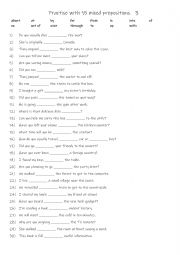
|
A1+-A2 Practise with 15 mixed prepositions 3
First, students need to familiarise themselves with the 15 prepositions and their use. Then they read the sentences to work out which preposition is needed to complete the gap-fill. Each tense is used 2 times! Answers on page 2
Level: elementary
Age: 8-100
Type:
Downloads: 112
|
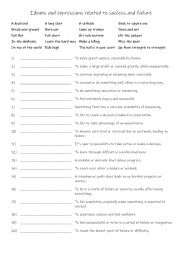
|
B1+-C1 Idioms and expressions related to success and failure
Learning idioms and expressions related to success and failure enriches students� language skills by helping them understand and communicate complex ideas more vividly and naturally. These idioms, like "hit rock bottom" or "make a killing", provide a deeper, more nuanced way to talk about personal and professional challenges, achievements, and se...
Level: intermediate
Age: 12-100
Type:
Downloads: 120
|
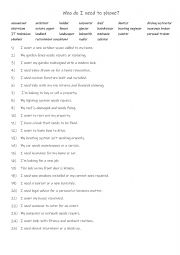
|
A1+-A2 Jobs - Who do I need to phone if....
Students familiarise themselves with the 25 jobs and what they do. Then students read each scenario and write down the type of job that will solve the problem. Answers on page 2.
Level: elementary
Age: 7-100
Type:
Downloads: 126
|
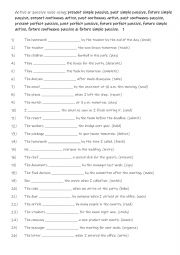
|
B1-B2 Active or passive voice using: present simple passive, past simple passive, future simple passive, present continuous active, past continuous active, past continuous passive, present perfect passive, past perfect passive, future perfect passive, fut
Learning active and passive voice across these tenses enhances students� ability to express ideas flexibly and appropriately. Passive voice focuses on the action or result, especially when the doer is unknown, unimportant, or implied, making it essential for formal contexts like academic writing, journalism, or reports. Active voice, on the other...
Level: intermediate
Age: 10-100
Type:
Downloads: 113
|
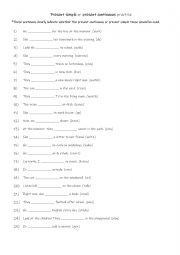
|
Present simple or present continuous practise
Students read the sentences and work out if the given infinitive need tobe in present simple or past simple tense.Present simple or present continuous practise
*These sentences clearly indicate whether the present continuous or present simple tense should be used.
Answers on page 2
Level: elementary
Age: 10-100
Type:
Downloads: 111
|
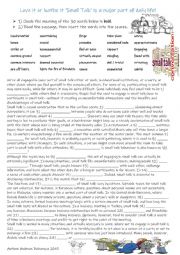
|
Love it or loathe it �Small Talk� is a major part of daily life!
800-Word reading article with a 30-word gap fill exercise about why people use small talk on a regular basis. It takes an deeper look at the reasons why people feel the need to chat to strangers; the benefits, what topics are suitable and those which are taboo.This sheet is suitable for higher level B1 to C1 students of all ages. An answer sheet is...
Level: intermediate
Age: 12-100
Type: worksheet
Downloads: 2081
|
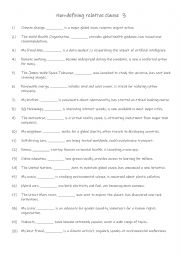
|
Non-defining relative clause 3
Students complete the gap-fill with the correct word. Answers on page 2.
Level: elementary
Age: 8-100
Type:
Downloads: 110
|
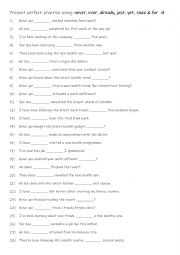
|
A2+-B1 Present perfect practise using never, ever, already, just, yet, since & for 4
First, students need to familiarise themselves with adverbs and their use. Then they read the sentences to see which one is needed to complete the gap-fill. Answers on page 2.
Level: elementary
Age: 9-100
Type:
Downloads: 104
|
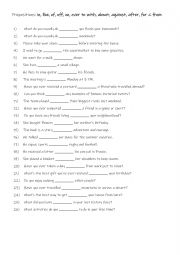
|
Prepositions: in, like, of, off, on, over to with, about, against, after, for & from
This gap-fill prepositions worksheet is suitable for A2-B1 students. Students read the sentences and questions and complete them with one of the eleven prepositions. After the prepositions have been checked, students could use this exercise as a speaking reinforcement component in pairs or small groups.Answers on page 2.
Level: elementary
Age: 10-100
Type: worksheet
Downloads: 111
|
|
|
|
|












